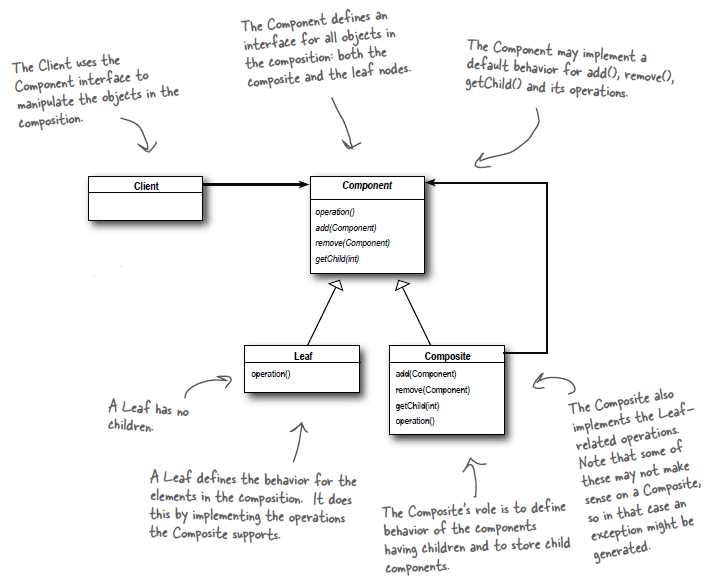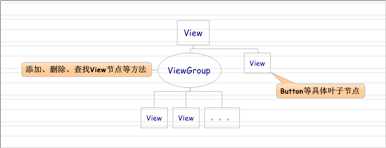标签:
| 组合模式定义: |
| Compose objects into tree structures to represent part-whole hierarchies. Composite lets clients treat individual objects and compositions of objects uniformly. |
| 将对象组合成树形结构以表示“部分-整体”的层次结构,使得用户对单个对象和组合对象的使用具有一致性。 |

如上图所示(截取自《Head First Design Patterns》一书),主要包括三个部分:
1. Component抽象组件。定义参加组合对象的共有方法和属性,可以定义一些默认的函数或属性。
2. Leaf叶子节点。构成组合树的最小构建单元。
3. Composite树枝节点组件。它的作用是组合树枝节点和叶子节点形成一个树形结构。
|
高层模块调用简单。一棵树形结构的所有节点都是Component,局部和整体对调用者来说都是一样的,没有区别,所以高层模块不比关心自己处理的是单个对象还是整个组合结构,简化了高层模块的代码。 |
| 节点自由扩展增加。使用组合模式,如果想增加一个树枝节点或者叶子节点都是很简单的,只要找到它的父节点就可以了,非常容易扩展,符合“开闭原则”。 |
| 应用最广的模式之一。应用在维护和展示部分-整体关系的场景,如树形菜单、文件夹管理等等。 |
在Android源码中,都能找到使用组合模式的例子,其中在《Android源码学习之观察者模式应用》介绍到的ViewGroup和View的结构就是一个组合模式,结构图如下所示:

现在来看看它们是如何利用组合模式组织在一起的,首先在View类定义了有关具体操作,然后在ViewGroup类中继承View类,并添加相关的增加、删除和查找孩子View节点,代码如下:
* @attr ref android.R.styleable#ViewGroup_clipChildren
* @attr ref android.R.styleable#ViewGroup_clipToPadding
* @attr ref android.R.styleable#ViewGroup_layoutAnimation
* @attr ref android.R.styleable#ViewGroup_animationCache
* @attr ref android.R.styleable#ViewGroup_persistentDrawingCache
* @attr ref android.R.styleable#ViewGroup_alwaysDrawnWithCache
* @attr ref android.R.styleable#ViewGroup_addStatesFromChildren
* @attr ref android.R.styleable#ViewGroup_descendantFocusability
* @attr ref android.R.styleable#ViewGroup_animateLayoutChanges
*/
public abstract class ViewGroup extends View implements ViewParent, ViewManager {
接着看增加孩子节点函数:
/**
* Adds a child view. If no layout parameters are already set on the child, the
* default parameters for this ViewGroup are set on the child.
*
* @param child the child view to add
*
* @see #generateDefaultLayoutParams()
*/
public void addView(View child) {
addView(child, -1);
}
/**
* Adds a child view. If no layout parameters are already set on the child, the
* default parameters for this ViewGroup are set on the child.
*
* @param child the child view to add
* @param index the position at which to add the child
*
* @see #generateDefaultLayoutParams()
*/
public void addView(View child, int index) {
LayoutParams params = child.getLayoutParams();
if (params == null) {
params = generateDefaultLayoutParams();
if (params == null) {
throw new IllegalArgumentException("generateDefaultLayoutParams() cannot return null");
}
}
addView(child, index, params);
}
/**
* Adds a child view with this ViewGroup‘s default layout parameters and the
* specified width and height.
*
* @param child the child view to add
*/
public void addView(View child, int width, int height) {
final LayoutParams params = generateDefaultLayoutParams();
params.width = width;
params.height = height;
addView(child, -1, params);
}
/**
* Adds a child view with the specified layout parameters.
*
* @param child the child view to add
* @param params the layout parameters to set on the child
*/
public void addView(View child, LayoutParams params) {
addView(child, -1, params);
}
/**
* Adds a child view with the specified layout parameters.
*
* @param child the child view to add
* @param index the position at which to add the child
* @param params the layout parameters to set on the child
*/
public void addView(View child, int index, LayoutParams params) {
if (DBG) {
System.out.println(this + "